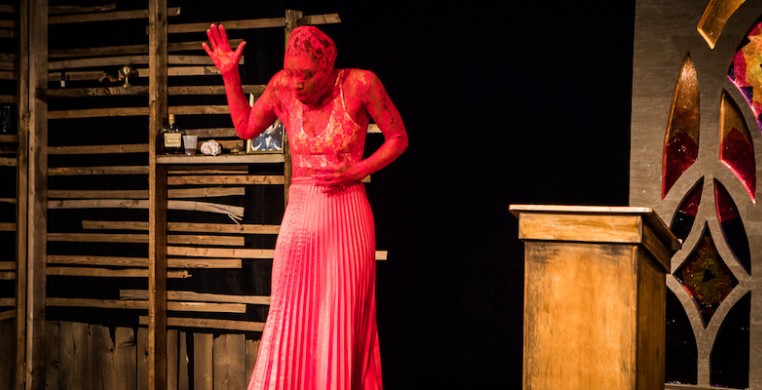This weekend, in the intimate Blanc Gallery on 45thand King Drive, exists a small congregation known as “The People’s Church of the G.H.E.T.T.O.” Led by Chicago Dancemakers Forum Lab Artist Jenn “Po’Chop” Freeman with performers Tiff Beatty, Felicia Holman, Shimmy LaRoux and Avery R. Young, the ministry exists to remember, pay homage to and call upon Chicago mothas and activists: Beauty Turner and Jackie Ormes, and Harlem-born poet Audre Lorde. “The People’s Church” is part-performance, part-installation, with a brown paper tent, large patches of brown paper covering other sections of the room, chairs and a couple of church pews sprinkled throughout. One entire wall is covered in open, brown paper bags and is not simply an inanimate object: it becomes one of the performers as it moves and rebounds off every swipe and gentle touch of Freeman’s fingers, arms and legs. An usher (played by LaRoux)—dressed in black and white polka-dots and a white and black hat that fans out on the side—welcomes us into the space. Some people have come dressed for church, while others have come as they are.
I’m given a program which outlines the order of service: the welcome; three sermonettes/reflections honoring Lorde, Turner and Ormes; devotion; offering and the benediction. Tiff Beatty brings service to order with a poem that calls on the name of Beauty Turner—a black woman who was a journalist and public housing activist in Chicago. Turner’s G.H.E.T.T.O. (“Greatest History Ever Told To Our People”) bus tours—which served as inspiration behind the name of “The People’s Church”—championed against Chicago Housing Authority’s (CHA) “Plan for Transformation” by giving tours of the soon to be demolished CHA complexes to activists, tourists and students. Beatty’s invocation opens with “Hey love, what’s happened to the land?” directed at a few folks in the audience before her lovely words wrap us in the beauty of Bronzeville—a neighborhood that was once booming with black businesses and wealth only to fight against the snares of gentrification and displacement. As Beatty remembers and pays homage to Bronzeville through stories of her own displacement, joys, confusion and triumph, the audience responds with “Ase’!” an Africanist expression of affirmation similar to the Protestant “Amen!”
After Beatty’s homage to Turner, comes the devotion. Po’Chop emerges from the brown paper tent in a red lace bodysuit, red pleated skirt, white and red gloves, and a bright red, lace parasol. She gasps for breath with every sharp turn of her head and moves stealthy through the row of chairs before hiding behind one of them. Lorde’s voice echoes quietly from the speakers as if to call Freeman from underneath the pews. Freeman leaps and twirls her umbrella above her head, only to collapse into the floor. She quickly changes her focus and opens her umbrella as if to defend herself from an invisible force. With a swift swipe of the leg, she again attempts to fly through space and pauses to slowly strip from her red, lacy shell that held both pain and comfort. Lorde’s last words, “It is better to speak knowing that we were never meant to survive,” lingers at the end of Freeman’s solo as she whispers “survive” and the names of Turner, Ormes and other black women into the paper bags. Layered on top of Lorde’s voice, Freeman’s solo demonstrates the beautiful tension that comes with being black and being a woman, being free and being bound.
The “service” continues with a hilarious version of church announcements led by Sister Shimmy LaRoux, and an altar call in which audience members are also welcomed, row by row, to call the names of black women and female-identified icons, and lay them at the altar. Young beautifully lines the hymn “My Magic is in My Hands” in the background, as the audience is welcomed to take white paper towels from a bar where he is singing. The ritualistic nature of the performance is refreshing as it leaves space for the audience to also take ownership in the ways we honor, praise and give reverence to black women who do the work in our communities.
“The People’s Church of the G.H.E.T.T.O.” is timely, as other black artists in Chicago and around the world are taking up expressions of the black church: gospel music, shouting, praising and ritual to explore the possibilities and tools available to marginalized groups seeking liberation. Po’Chop invites us to indulge in the history of black women, with the understanding that if we acknowledge and affirm their work it will take us from glory, to glory, to glory. Ase’.
—
"The People's Church of the G.H.E.T.T.O" continues through Sept. 15 at Blanc Gallery, 445 S. King Drive. Tickets are $10-$30, available by clicking the event page below.

